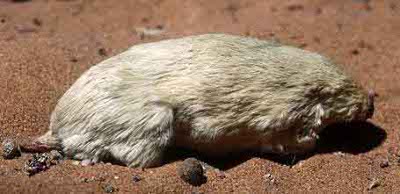Marsupial Mole
Category: Marsupial

Facts about Marsupial Mole. "Scientific name for is Notoryctes caurinus". The Marsupial mole is one of the breeds of marsupials that belong to the Notoryctemorphia family. They are uncommon and feebly understood burrowing animals of the Western Australian deserts, with an origin going back to 20 million years. Though the Marsupial Mole breed are categorized as a monotreme, currently they are recognized to be a marsupial.
Appearance of Marsupial Mole
The head of the Marsupial mole is in the shape of a cone that appears with a leathery guard over the muzzle. It has a tubular body, and the tail is a small, bald stub. The Marsupial Mole breeds appear with a body length, ranging from 4 3/4 to 5 1/4 inches (12 cm to 16 cm), and have a body weight between 1.4 to 2.1 ounce (40 grams to 60 grams). The Marsupial Mole body is consistently covered in fairly short, and extremely superior pale cream to white colored hair with a sparkling golden shine. The Marsupial Mole small bag has developed to face backwards so it does not pack with sand, and holds just two teats, so the mammal cannot put up with more than two young ones simultaneously.
Features of Marsupial Mole
The limbs of the Marsupial Mole breeds are extremely short, with abridged digits. The front feet have two big claws, and have even claws on the third and fourth legs that are exploited to dig the soil. The back feet are compact, and put up with three small claws, which are used to drive the soil behind the mammal while it digs.
A Marsupial mole spends the majority of its time underground, coming to the outside only rarely, most likely following rains. Marsupial moles are blind, and their eyes having turned out to be abridged to vestigial lenses below the skin and they have no outside ears. They have just a pair of small holes concealed under bulky hair. They do not excavate eternal burrows, but pack their tunnels at the back of them while they move.
Diet of Marsupial Mole
Marsupial Moles mostly feed on the Juicy beetle larvae. They also eat Mulga seeds, leaf scale insects, ant eggs and the rare gecko.

 Back To Category Marsupial
Back To Category Marsupial